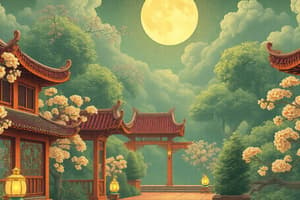Podcast
Questions and Answers
Qing Dynasty
Qing Dynasty
- 1912
- 1644 (correct)
- 1368
- 1722
Ming Dynasty
Ming Dynasty
- 1368 (correct)
- 1644
- 1722
- 1912
Qing Dynasty
Qing Dynasty
- Taizong
- Qianlong
- Kangxi (correct)
- Yongzheng
Ming Dynasty
Ming Dynasty
Flashcards are hidden until you start studying
Study Notes
Qing Dynasty Politics
- Last imperial dynasty in China, ruling from 1644 to 1912
- Founded by the Manchu people from northeastern China, who conquered the Ming Dynasty
- Key features:
- Centralized bureaucracy with the emperor at the top
- Divide and rule policy: Manchu people held key positions, while Han Chinese were excluded from power
- Eight Banners system: military organization that combined Manchu and Han Chinese troops
- Examination system: revived and expanded to recruit officials
- Provincial administration: divided into provinces, each governed by a governor and a governor-general
- Notable emperors:
- Kangxi (1662-1722): longest-reigning emperor, expanded empire's borders, and established a strong centralized government
- Yongzheng (1722-1735): implemented reforms, including the creation of a secret police system
- Qianlong (1735-1796): expanded empire's borders, and established a policy of isolationism
Ming Dynasty Economy
- Economy during the Ming Dynasty (1368-1644):
- Agriculture: primary sector, with significant growth in rice and cotton production
- Silk production: major industry, with the Silk Road playing a significant role in international trade
- Porcelain production: famous Jingdezhen porcelain was exported globally
- Maritime trade: significant trade with Southeast Asia, Japan, and Europe
- Copper currency: used as the primary medium of exchange
- Key economic policies:
- Land reform: equal distribution of land to reduce poverty and inequality
- Taxation: implemented a single-whip tax system, where a single tax was levied on all landowners
- Monetary policy: controlled copper supply to maintain currency stability
- State monopolies: controlled key industries, such as salt, iron, and tea
Chinese Imperial System
- Key features:
- Emperor: supreme ruler, considered the son of heaven, with divine authority
- Imperial examination system: competitive exams to recruit officials, based on Confucian classics
- Central government:
- Emperor: at the top, with absolute power
- Grand Secretariat: advisory body, responsible for policy-making
- Six Ministries: responsible for administration, including personnel, revenue, rites, war, justice, and public works
- Provincial administration: divided into provinces, each governed by a governor and a governor-general
- Bureaucracy: hierarchical system, with officials appointed based on examination results
- Eunuchs: played a significant role in imperial politics, often serving as advisors and administrators
清朝政治
- 1644-1912年统治中国的最后一个皇朝
- 由东北中国的满洲人所建立,推翻明朝
- 政治特点:
- 以皇帝为中心的中央集权局
- 分而治之政策:满洲人担任关键岗位,汉人被排除在权力之外
- 八旗制度:军事组织,结合满洲人和汉人军队
- 考试制度:复兴和扩展,招募官员
- 省份行政:分为省份,每个省份由总督和巡抚管理
- 著名皇帝:
- 康熙(1662-1722):在位时间最长,扩展帝国边界,建立强有力的中央政府
- 雍正(1722-1735):实施改革,包括创建秘密警察制度
- 乾隆(1735-1796):扩展帝国边界,推行孤立主义政策
明朝经济
- 明朝(1368-1644)经济:
- 农业:主要部门,稻米和棉花生产大幅增长
- 丝绸生产:主要产业,丝绸之路在国际贸易中扮演重要角色
- 陶瓷生产:著名的景德镇瓷器出口全球
- 海洋贸易:与东南亚、日本和欧洲的贸易规模庞大
- 铜币货币:作为主要的交换媒介
- 经济政策:
- 土地改革:平等分配土地,减少贫困和不平等
- 税收政策:实施单鞭税制,所有土地所有者缴纳单一税
- 货币政策:控制铜供应,维持货币稳定
- 国家垄断:控制主要产业,如盐、铁、茶
中国帝国制度
- 关键特点:
- 皇帝:至高无上的统治者,认为是天之子,具有神权
- 科举制度:以儒家经典为基础的竞争性考试,招募官员
- 中央政府:
- 皇帝:至高无上的统治者,拥有绝对权力
- 内阁:政策顾问机构,负责政策制定
- 六部:负责行政管理,包括人事、财政、礼、兵、刑、工
- 省份行政:分为省份,每个省份由总督和巡抚管理
- 官僚制度:层层制度,官员根据考试结果任命
- 太监:在帝国政治中扮演重要角色,经常担任顾问和行政长官
Studying That Suits You
Use AI to generate personalized quizzes and flashcards to suit your learning preferences.




